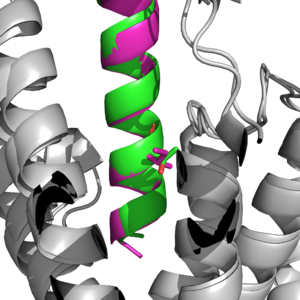User:SaraKathryn Kalkhoff/Sandbox 1
From Proteopedia
(Difference between revisions)
| Line 4: | Line 4: | ||
== Introduction == | == Introduction == | ||
[https://www.sciencedirect.com/topics/medicine-and-dentistry/gastric-inhibitory-polypeptide The Glucose-dependent Insulinotropic Polypeptide (GIP) is a ligand that can be bound to its receptor (GIP-R) to help facilitate the breakdown of glucose.] This is the basis of what makes up one of the key ways that glucose is bound and broken down into different parts, including insulin, to be able to maintain blood glucose levels within the body. With this structure, it is also to work with the GLP-1 receptors found within cells to help break down glucose present within cells to create energy. | [https://www.sciencedirect.com/topics/medicine-and-dentistry/gastric-inhibitory-polypeptide The Glucose-dependent Insulinotropic Polypeptide (GIP) is a ligand that can be bound to its receptor (GIP-R) to help facilitate the breakdown of glucose.] This is the basis of what makes up one of the key ways that glucose is bound and broken down into different parts, including insulin, to be able to maintain blood glucose levels within the body. With this structure, it is also to work with the GLP-1 receptors found within cells to help break down glucose present within cells to create energy. | ||
| - | [[Image | + | [[Image gipglp.png:|300px|right|thumb|Figure 1: GIP vs GLP receptor function with pathways.]] |
== Function == | == Function == | ||
| - | The GIP receptor helps facilitate movement of glucose within a cell. <ref name='Sun'>PMID:35333651</ref>. It has a natural ligand that is 42 residues and helps kickstart the GIP-R into firing, as a transporter for glucose in and out of the cell. Once the levels become too high, the ligand | + | The GIP receptor helps facilitate movement of glucose within a cell. <ref name='Sun'>PMID:35333651</ref>. It has a natural ligand that is 42 residues and helps kickstart the GIP-R into firing, as a transporter for glucose in and out of the cell. Once the levels become too high, the ligand will send this transporter back down into the cell and not have anymore glucose activate. It will also cause the insulin pathway to start to help signal that there is too much glucose in the body. |
===Tirzepatide=== | ===Tirzepatide=== | ||
Tirzepatide has been used as a treatment for Type 2 diabetes and <scene name='10/1037492/Just_tirz/1'>Tirzepatide has a total of 39 residues present in its structure.</scene> It is used to help treat Type 2 Diabetes, as an agonist to allow insulin to be broken down. This also works in tandem with GLP-1... It also contains two residues with an AIB sequence, which stands for alpha-amino isobutric acid and aids with preventing degradation of the peptide <ref name='Chavda>PMID: 35807558</ref>. | Tirzepatide has been used as a treatment for Type 2 diabetes and <scene name='10/1037492/Just_tirz/1'>Tirzepatide has a total of 39 residues present in its structure.</scene> It is used to help treat Type 2 Diabetes, as an agonist to allow insulin to be broken down. This also works in tandem with GLP-1... It also contains two residues with an AIB sequence, which stands for alpha-amino isobutric acid and aids with preventing degradation of the peptide <ref name='Chavda>PMID: 35807558</ref>. | ||
Revision as of 20:18, 12 April 2024
| |||||||||||

